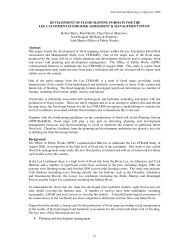Vegetation (Floating River Vegetation) - Office of Public Works
Vegetation (Floating River Vegetation) - Office of Public Works
Vegetation (Floating River Vegetation) - Office of Public Works
Create successful ePaper yourself
Turn your PDF publications into a flip-book with our unique Google optimized e-Paper software.
2.1.4 Lower <strong>River</strong> Shannon Special Area <strong>of</strong> Conservation IE 0002165<br />
The Lower <strong>River</strong> Shannon SAC extends from Killaloe to Loop Head / Kerry Head covering<br />
one hundred and twenty kilometres. Within the Lower <strong>River</strong> Shannon SAC there are four<br />
significant river estuaries, namely the Shannon, Feale, Mulkear and Fergus along with stretches <strong>of</strong><br />
freshwater between Killaloe and Limerick. The bedrock <strong>of</strong> both the <strong>River</strong> Shannon and the Fergus<br />
consist <strong>of</strong> Carboniferous limestone, Namurian shale, flagstones and Old Red Sandstone. Namurian<br />
Rocks and Carboniferous Limestone form the bedrock for the <strong>River</strong> Feale with Lower Palaeozoic<br />
Rocks, Namurian Rocks, Lower Carboniferous Shale and Carboniferous Limestone forming the<br />
bedrock <strong>of</strong> the Mulkear <strong>River</strong> (National Parks and Wildlife Services website)<br />
Three main rivers flowing into the Lower Shannon Special Area <strong>of</strong> Conservation are the<br />
<strong>River</strong> Shannon, the Fergus <strong>River</strong> and the Cloon <strong>River</strong>. Some other rivers, included in the Lower<br />
<strong>River</strong> Shannon SAC, are the Mulkear and Kilmastulla <strong>River</strong> tributaries <strong>of</strong> the <strong>River</strong> Shannon, the<br />
<strong>River</strong> Feale and the <strong>River</strong> Maigue. <strong>Floating</strong> river vegetation recorded on the Lower Shannon SAC<br />
include Water Crowfoot Ranunculus species on the <strong>River</strong> Fergus, pondweed Potamogeton species<br />
and the protected pondweed Groenlandia densa. It is highly probable that water crowfoot species,<br />
(Ranunculus species) are present on the <strong>River</strong> Shannon but this is still unconfirmed. The aquatic<br />
moss Fontinalis antipyretica has been identified on all three-river systems (Natura, 2000).<br />
2.1.5 Bandon <strong>River</strong> Special Area <strong>of</strong> Conservation IE 0002171<br />
The Bandon <strong>River</strong> flows from a north to south direction east <strong>of</strong> the village <strong>of</strong> Dunmanway in<br />
West Cork. The Bandon <strong>River</strong> SAC encompasses both the Bandon <strong>River</strong> and a short adjoining<br />
section <strong>of</strong> the Caha <strong>River</strong>, a tributary <strong>of</strong> the Bandon <strong>River</strong>. To the north Old Red Sandstone is the<br />
dominant bedrock with Carboniferous Slate to the south <strong>of</strong> Dunmanway. Peat, podzols and skeletal<br />
soils are the main soil types north <strong>of</strong> the river with alluvial soils and brown Podzolics to the south.<br />
In the course <strong>of</strong> its journey the Bandon <strong>River</strong> cascades through narrow valleys to the north,<br />
meandering through fertile floodplains at Dunmanway and through a broad, flat valley with a<br />
reduced flow gradient to the south (National Parks and Wildlife Services website).<br />
<strong>Floating</strong> river vegetation was identified as an important EU habitat on the Bandon <strong>River</strong><br />
along with alluvial forest, a priority habitat. Recorded floating river vegetation includes Water<br />
Crowfoot Ranunculus spp., Milfoil Myriophyllum alterniflorum, Pondweed Potamogeton natans,<br />
four varieties <strong>of</strong> Starworts Callitriche hamulata, Callitriche obtusangula, Callitriche platycarpa<br />
and Callitriche stagnalis and the aquatic moss Fontinalis antipyretica. Ranunculus sp. is reported to<br />
be the dominant floating river vegetation on the Bandon <strong>River</strong> (Natura, 2000).<br />
7

















